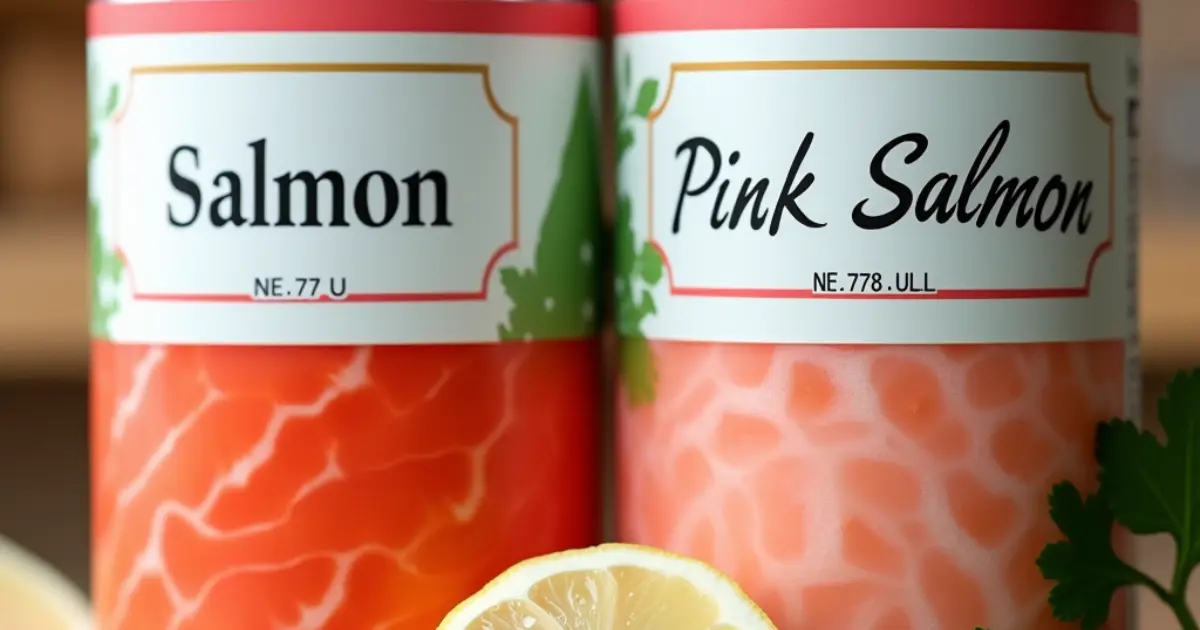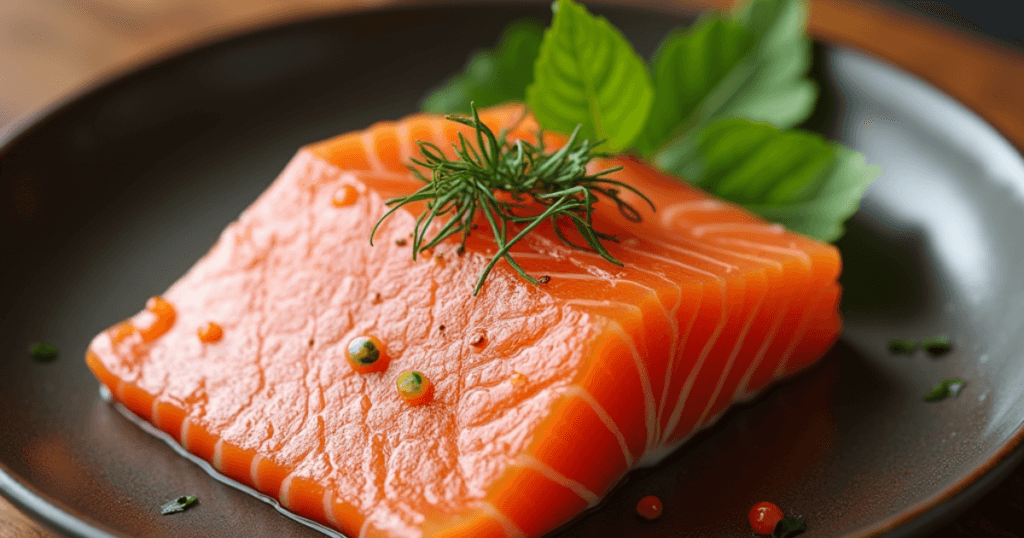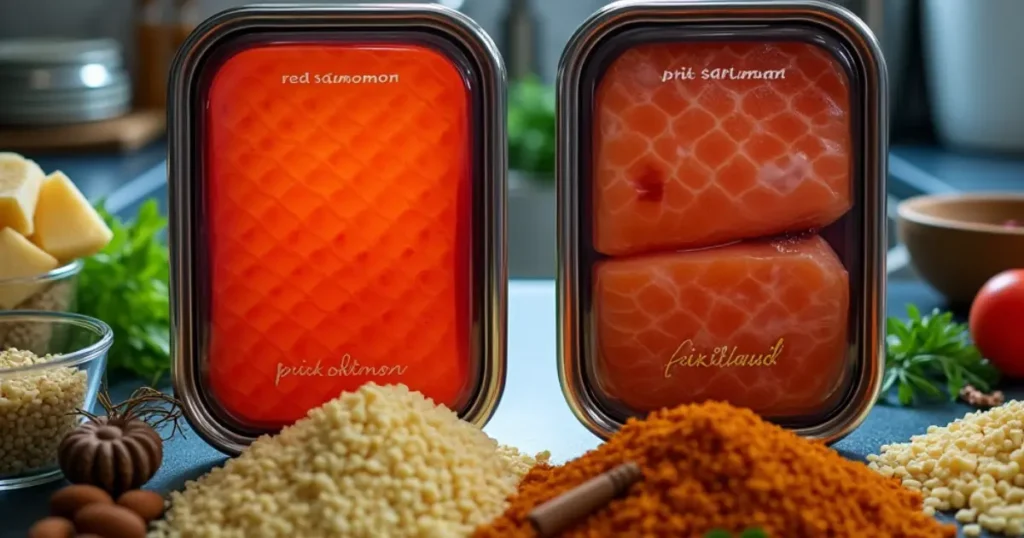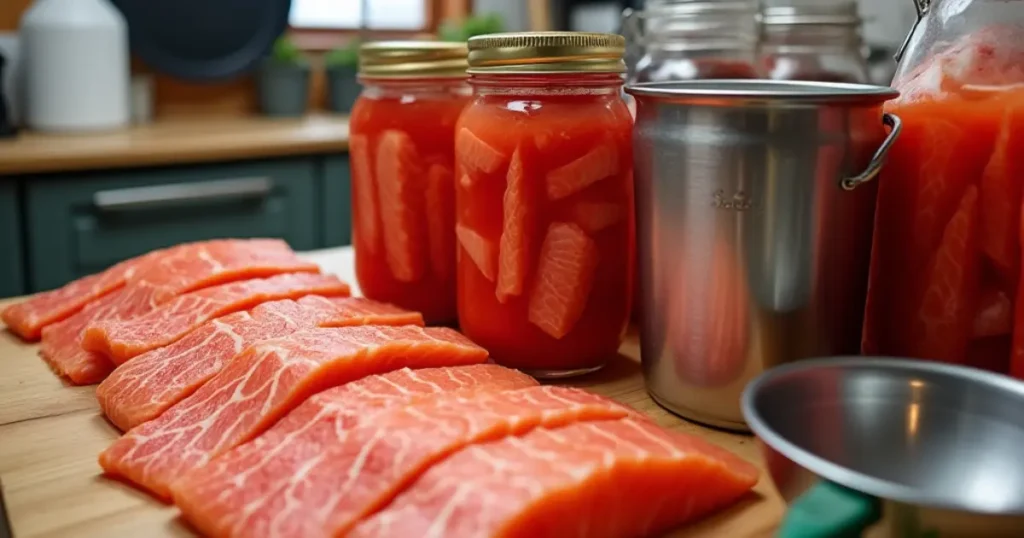Red vs Pink Canned Salmon for Loaf: best 3 Tips

If you’re a fan of salmon like I am, you’ve likely wondered about the difference between red and pink canned salmon. My grandmother’s famous salmon loaf owes much of its success to using both types . Now, I’m here to pass on that knowledge so you can create a salmon loaf everyone will love.
Whether you’re an experienced cook or just starting out, understanding the difference between red and pink salmon is essential. Each variety has its own distinct color and flavor, adding something special to your dish. Let’s take a closer look at how to choose the right salmon for your next delicious creation.
Introduction
When browsing canned salmon, you’ll come across two main varieties: red and pink. While they may seem similar at first glance, there are important differences between them. Understanding these can help you choose the perfect canned salmon for your dish.
Red salmon, or sockeye , is known for its vibrant color and bold flavor. It’s typically more expensive, with a firm texture and a stronger taste that stands out in dishes. Pink , on the other hand, offers a milder flavor and softer texture. It’s usually more affordable, making it a great option for adding more fish to your meals without breaking the bank.
The color differences between red and pink stem from their diets and natural environments. Sockeye salmon, which is red, gets its rich color from consuming krill and shrimp. In contrast, pink salmon has a lighter hue due to its diet of plankton and small crustaceans.

These color and flavor distinctions also influence how each type of salmon works in a recipe, especially in dishes like a salmon loaf. Red salmon’s firmer texture and stronger flavor make it ideal for heartier dishes, while the softer texture of pink lends itself better to lighter, more delicate recipes. Ultimately, your choice between red and pink canned salmon comes down to your personal preference for taste and texture.
“The differences between red and pink canned salmon go beyond their appearance. These color variations reflect the salmon’s natural diet and habitat.”
Flavor Profiles: Red vs. Pink Salmon
The debate over red (sockeye) versus pink salmon in canned varieties is fascinating because the flavor differences can significantly impact your dishes’ taste and versatility.
Red salmon, or sockeye, is known for its bold, distinctive flavor. It’s often described as slightly sweet with a nutty undertone, making it ideal for dishes that require a stronger seafood taste. It pairs beautifully with bold seasonings and sauces, enhancing hearty recipes.
In contrast, pink has a more mild and delicate flavor, which makes it perfect for dishes that require a more subtle touch. Its gentler taste allows other ingredients to shine through.
The flavor difference between red and pink plays a key role in cooking, and your choice depends on both your personal taste and the recipe you’re preparing. Try both varieties to discover which one works best for your favorite salmon dishes.
| Flavor CharacteristicsRed (Sockeye) SalmonPink SalmonOverall TasteBold, distinctive, slightly sweet and nuttyPairing RecommendationsStands up well to bold seasonings and sauces | Flavor CharacteristicsRed (Sockeye) SalmonPink SalmonOverall TasteBold, distinctive, slightly sweet and nuttyPairing RecommendationsStands up well to bold seasonings and sauces | Flavor CharacteristicsRed (Sockeye) SalmonPink SalmonOverall TasteBold, distinctive, slightly sweet and nuttyPairing RecommendationsStands up well to bold seasonings and sauces |
“The flavor of red salmon is truly unique and unforgettable, with its bold, distinctive taste. On the other hand, the delicate flavor of pink provides a more versatile canvas, perfect for a wide range of culinary creations.”
Nutritional Value: A Comparison
Canned salmon, whether red or pink, is a powerhouse of nutrients. However, the key difference lies in their omega-3 fatty acid content.
Omega-3 Content and Health Benefits
Red canned salmon contains higher levels of omega-3s, including EPA and DHA. These healthy fats are known for their heart and brain benefits.
Research shows that omega-3s are linked to a lower risk of heart disease, reduced inflammation, and improved brain function. So, opting for red canned salmon gives you a greater boost of these beneficial fats.
Nutrient Comparison: Red vs. Pink Canned Salmon
| Nutrient | Red Canned Salmon | Pink Canned Salmon |
| Omega-3 Fatty Acids | 1.7 grams per 3.5 oz serving | 0.8 grams per 3.5 oz serving |
| Protein | 22 grams per 3.5 oz serving | 20 grams per 3.5 oz serving |
| Calories | 155 per 3.5 oz serving | 142 per 3.5 oz serving |
Red canned higher omega-3 content makes it an excellent choice for those seeking more of these heart-healthy fats. However, both red and pink canned salmon are fantastic options for a nutritious diet.
“Eating canned salmon is a great way to enjoy the benefits of omega-3 fatty acids and other essential vitamins and minerals, all without the hassle of preparing fresh fish.”

Texture and Flakiness: What to Expect
The texture of canned fish plays a big role in the outcome of your dish. Red salmon, or sockeye, is known for its firm, dense texture. This sturdiness helps your salmon loaf stay intact, holding its shape well when baked and sliced.
Texture Comparison: Red vs. Pink Salmon
| Texture Attribute | Red Salmon | Pink Salmon |
| Firmness | Firm and dense | Delicate and flaky |
| Cohesion | Holds shape well | Tends to break apart more easily |
| Mouthfeel | Robust and substantial | Soft and light |
In contrast, pink salmon offers a softer, flakier texture, creating a tender and easy-to-eat salmon loaf. Ultimately, the choice between red and pink salmon comes down to your texture preference for the dish.
Choosing the right canned salmon for your loaf depends on the texture you desire. Red salmon’s firmness is perfect for a more solid loaf, while pink salmon’s flakiness results in a softer, more delicate texture.
“The texture of the salmon can make or break a salmon loaf. It’s an essential factor when selecting the right canned variety for your recipe.”
Sustainable Seafood: Choosing Responsibly
When selecting canned salmon for your loaf, it’s important to consider its origin. Wild-caught salmon, such as sockeye (red) and pink, are better for the planet. They breed and feed naturally, helping maintain healthy ocean ecosystems.
By choosing canned salmon from sustainable sources, you’re supporting eco-friendly fishing practices that keep our oceans full of life. This ensures that this delicious protein remains available for years to come.
Look for labels like “wild-caught” or “sustainably sourced” to make an eco-conscious choice. Research the fishing practices and certifications of the brand to confirm their commitment to sustainability. Regions known for sustainable fishing, such as wild-caught Alaskan salmon, are great options.
Choosing sustainable seafood supports healthy oceans, allowing future generations to enjoy the taste and health benefits of wild-caught salmon.
“Choosing sustainable seafood is an easy way to make a positive impact on the health of our oceans and the planet. By selecting canned salmon from responsible sources, we can savor the delicious flavor while supporting the long-term preservation of this valuable resource.”
Red vs. Pink Canned Salmon for Loaf
When choosing between red and pink canned salmon, it can make a big difference in how your salmon loaf turns out. Each variety has its unique qualities, so understanding their differences will help you create a loaf that suits your tastes and cooking goals.
The Bold Flavor of Red Salmon
Red salmon, or sockeye salmon, is known for its bold, robust flavor. Its firmer texture gives the loaf more substance, making it ideal for those who want a hearty, full-bodied taste with a sturdy texture. Red salmon brings a stronger, more pronounced seafood flavor to your dish.
The Delicate Charm of Pink Salmon
Pink salmon, or humpback salmon, has a milder, more delicate flavor and a flakier texture. This makes it perfect for those who prefer a softer, lighter seafood experience. Pink salmon is also incredibly versatile and works well in a variety of recipes, making it a great choice for more subtle, refined dishes.
Nutritional Considerations
Red salmon typically contains higher levels of omega-3 fatty acids, which are beneficial for heart and brain health. This makes it a great option for those looking to boost their nutrition.
Ultimately, the choice between red and pink salmon comes down to your personal taste and the kind of dish you’re aiming to create. Whether you prefer the bold flavor of red salmon or the milder taste of pink salmon, both varieties can help you make a delicious and nutritious loaf.
Salmon Loaf Recipe Variations
Salmon loaf is a versatile dish that can be made with either red or pink canned salmon—or even a combination of both. Each type of salmon brings out different qualities in the dish. For example, a red salmon loaf pairs wonderfully with bold flavors and rich sauces, while a pink salmon loaf shines with lighter, more subtle tastes.
By experimenting with red and pink salmon in various ways, you can explore their unique flavors and textures. This allows you to customize your recipe and find the perfect balance that suits your taste preferences.
Incorporating Red and Pink Salmon into Delicious Dishes
The choice between red and pink salmon can significantly influence the taste of your salmon loaf recipes. Red salmon, with its deeper color and bolder taste, pairs wonderfully with strong, rich flavors. Pink salmon, on the other hand, offers a lighter color and milder taste, making it ideal for more delicate, subtle dishes.
To get the best of both worlds, here are some ideas for mixing red and pink salmon in your salmon loaf recipes:
- Layered Loaf: Create a striking contrast by layering red salmon at the bottom and pink salmon on top. This adds both visual appeal and a delightful flavor contrast.
- Blended Loaf: Combine red and pink canned salmon for a perfectly balanced flavor and texture, incorporating the best qualities of both varieties.
- Red Salmon as the Base: Use red salmon as the main ingredient and add pink salmon as a topping or glaze to add a touch of color and a slightly sweeter note.
- Flavor Pairings: Experiment with different spices, herbs, and sauces to complement the unique qualities of each type of salmon. This way, you can tailor your salmon loaf to your ideal taste.
By exploring these variations, you’ll find the perfect combination of red and pink salmon that suits your flavor preferences and cooking style.
Nutrition Facts (per serving)
| Nutrient | Red Salmon Loaf | Pink Salmon Loaf |
| Calories | 201 | 201 |
| Fat | 12g | 12g |
| Saturated Fat | 2g | 2g |
| Cholesterol | 67mg | 67mg |
| Carbohydrates | 8g | 8g |
| Protein | 15g | 15g |
| Sodium | 140mg | 140mg |
| Potassium | 263mg | 263mg |
Both red and pink salmon loaf offer similar nutritional values, with each providing a healthy dose of protein and essential nutrients. The choice between the two will depend more on flavor and texture preferences rather than significant differences in nutrition.
“Salmon loaf is a versatile dish that can be made with either red or pink canned salmon, or even a combination of both, allowing you to tailor the flavor and texture to your liking.”
Budget-Friendly Protein Source
Protein is essential for a balanced diet, but high-quality protein can often be pricey. Canned , whether red or pink, offers an affordable and convenient option for nutritious meals.
Canned salmon is more budget-friendly than fresh, making it a great choice for those looking to save money while still eating well. Understanding the difference between red and pink canned salmon helps you choose the best option for your taste preferences and recipes, all while keeping your meals cost-effective.
Nutritional Information (per 2-patty serving)
| Nutrient | Value |
| Calories | 201 |
| Fat | 12g |
| Saturated Fat | 2g |
| Cholesterol | 67mg |
| Carbohydrates | 8g |
| Protein | 15g |
| Sodium | 140mg |
This nutritional breakdown highlights a balanced serving with a good amount of protein, healthy fats, and moderate sodium, making it a solid choice for a filling, nutritious meal.
The table provides the nutritional information for salmon cakes made with canned —an affordable protein source. With healthy fats, protein, and few carbs, it’s a versatile and budget-friendly option.
Use canned salmon for quick loaf, tasty salmon cakes, or in your favorite dishes. It’s a pantry staple that’s great for both your wallet and your health. Try canned salmon as a budget-friendly option and explore a variety of tasty and nutritious meals.

Canning Process: Preserving Salmon’s Freshness
The canning process is essential for preserving salmon’s freshness and ensuring it retains its full range of nutrients. It locks in the fish’s natural flavors and valuable nutrients, making canned salmon a long-lasting and convenient protein option for your recipes.
The process begins with high-quality, fresh salmon being cleaned and prepared. The fish is then cooked by steaming or baking to ensure it’s safe to eat. After cooking, is packed into airtight cans or jars.
The sealed cans or jars are then heated to a high temperature through a method called retorting. This heat treatment kills off bacteria and significantly extends the salmon’s shelf life, while preserving its flavor, texture, and nutritional value.
Thanks to this careful canning process, salmon maintains its freshness and essential nutrients, including omega-3 fatty acids, protein, and vitamins. Canned salmon is a nutritious and tasty addition to any recipe, offering both convenience and health benefits.
The canning process also ensures that the salmon is safe to eat. The airtight seal and high heat prevent bacteria from growing, making canned fish a reliable and shelf-stable choice for your kitchen.
When selecting canned salmon for your loaf, opt for high-quality, responsibly sourced options. These should have undergone the canning process to preserve the fish’s freshness and nutritional value.
Wild-Caught vs. Farmed
Choosing the right canned salmon for your loaf is essential. Wild-caught , such as sockeye (red) and pink salmon, are known for their superior taste and quality. They consume a natural diet and live in the ocean, contributing to their richer, more robust flavor.
On the other hand, farmed salmon tends to have a milder taste due to differences in diet and living conditions. Knowing the distinctions between wild-caught and farmed salmon will help you select the best option to match your flavor preferences for the perfect salmon loaf.
Exploring the Differences in Flavor and Quality
The flavor and quality of canned salmon can vary depending on whether it’s wild-caught or farmed. Wild-caught , such as sockeye (red) and pink salmon, are renowned for their bold, distinctive flavor and firm texture. They eat a natural diet and live in their ocean habitats, contributing to their unique and richer taste.
In contrast, farmed salmon tends to have a softer, less flaky texture. Their flavor is milder due to the controlled diet and living conditions. This makes farmed salmon different from its wild-caught counterparts in both taste and texture, offering a subtler seafood experience.
Knowing the differences between wild-caught and farmed helps you choose the right canned salmon. This choice will enhance your salmon loaf recipe and meet your taste preferences.
Salmon Comparison: Wild-Caught vs. Farmed
| Characteristic | Wild-Caught Salmon | Farmed Salmon |
| Flavor | Rich, robust, and distinctive | Milder, more subtle |
| Texture | Firm and flaky | Softer and less flaky |
| Diet | Natural, diverse diet in the ocean | Controlled, limited diet in captivity |
| Environment | Native ocean habitats | Farmed, enclosed environments |
Affordable Luxury: Elevating Canned Salmon
Canned salmon, whether red or pink, is a versatile and budget-friendly choice for home cooks. With the right preparation and flavor pairings, it can elevate simple dishes into luxurious meals. Canned salmon offers a nutritious and affordable seafood option without the high cost of fresh.
One of the great benefits of canned salmon is its convenience—it’s already cooked, saving you time in the kitchen. Plus, it’s more affordable than fresh salmon, making it easier to include seafood in your diet.
To make canned salmon dishes stand out, try pairing it with bold, complementary flavors. You could mix it with a creamy cheese sauce for a savory salmon loaf, or add a zesty lemon-dill dressing to create a refreshing salad. The possibilities are endless when it comes to turning canned salmon into a gourmet experience.
In addition to its convenience and affordability, canned salmon is packed with nutrients. It’s a fatty fish rich in omega-3 fatty acids, which are beneficial for both heart and brain health. Adding canned salmon to your meals not only brings great taste but also delivers health benefits, all without the price tag of fresh salmon.
So, when you’re looking to elevate your meals, consider canned salmon. With a bit of creativity, you can turn it into a luxurious dish that will impress your loved ones.
“Canned salmon is a true kitchen staple, offering the flavor and nutrition of this incredible seafood without breaking the bank.”
Conclusion
Choosing between red and pink canned for your salmon loaf ultimately depends on your taste preferences and the type of dish you want to create. Red salmon offers a bold flavor and firm texture, making it ideal for hearty loaves. In contrast, pink salmon has a milder taste and a flakier texture, perfect for lighter dishes.
Consider factors like nutritional value, sustainability, and budget when deciding which type of salmon to use. Understanding the differences between red and pink salmon will help you choose the best option for your recipe and personal taste.
Using canned fish in your cooking is a smart, budget-friendly choice. It’s a versatile, nutritious protein that can elevate your meals. Experiment with different types of canned salmon to find the one that fits your style and flavor preferences. With the right choice, you’ll create a salmon loaf everyone will love.
FAQ
Red salmon has a bold flavor and firm texture, while pink salmon is milder and flakier.
Red salmon has more omega-3s than pink salmon.
Red salmon is firm and dense, while pink salmon is softer and flakier.
